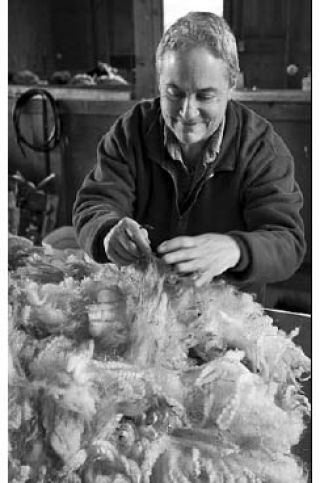Ever wonder what happens to all the wool from Lopez sheep? For the past year and a half, a lot of it has ended up with Maxine Bronstein and Debbie Hayward at their Lopez business Island Fibers.
I spent a morning with them in their studio recently and discovered their passion for Lopez fleece and the pleasure they find in transforming local fleece and sharing it with others.
“There’s such a variety of fleece on Lopez and the quality here is excellent,” Maxine and Debbie told me as they pointed to large bags packed with white, gray and brown wool. “From among the many breeds of sheep found on the island, we are using fleece from the purebred flocks of Romney, Coopworth, Icelandic and Navajo Churro. Each type of wool has characteristics that make it especially suitable for a specific purpose—from fine fiber for soft garments worn next to the skin to the coarser, strong fibers that make excellent rugs and weather-resistant outer clothing.” They also use fleece from a few mixed flocks on the island that have been bred specifically to produce beautiful fleece for hand spinners with colors ranging from off-white to dark brown.
The process of transforming the fleece begins at shearing. “We go to each farm at shearing time, pick up each fleece, spread it out and skirt it, removing all the undesirable parts.” Later they sort the fleece according to the kinds of yarn they want to make and send it to a mill for spinning. “Or if the fleece is just so beautiful we can’t part with it, we’ll keep it to spin ourselves,” they said, laughing. Island Fibers offers a range of natural-colored yarns, as well as their own hand-dyed and hand-painted colorways (variegated and multi-shaded yarns). Handspun yarn is also available.
“People see what we do and say ‘Wow, I didn’t know what it takes to go from the sheep to the yarn; that must be a lot of work.’ We answer that it does take a lot of time, but it doesn’t feel like work. Everything has to be washed many times: the fleece, the yarn that comes back from the mill, the dyed wool. Every single skein is touched many, many times and that’s before making anything out of it.” Many more hours go into creating rugs and blankets, sweaters, mittens, socks and hats.
Reflecting on the time commitment, they added, “We call ourselves part of the Slow Fiber Movement. It’s great to be able to slow down and be fully in the present. We used to stop and smell the roses; now we also stop and sniff the fleece.”
Another source of pleasure is people’s responses to their work. “I sometimes spin at the Farmer’s Market,” Maxine said, “and people of all ages come up and say ‘So that’s how you make yarn!’” Debbie added: “To be able to share this Lopez fleece from start to finish with people and to see the joy and also the comfort it brings into someone else’s life is so inspiring.” And for both of them, there’s the pleasure in knowing that local sheep farmers go to Chimera Gallery and point out their wool in Island Fibers hand-woven and hand-knit articles. “We’re so grateful to Lopez sheep farmers for this fabulous wool.”
To see some of Debbie and Maxine’s Lopez fleece creations, check out their show at Chimera Cooperative Artists Gallery, March 14 – April 10, 2009 and meet them at the opening reception Saturday, March 14, 5-7 p.m. And visit their website: http://www.islandfibers.com/ or make an appointment to visit their studio: 468-2467.



